Dorylus (Anomma) molestus (Gerstćcker) - revived
status
 Male Male   Type location Mozambique
(Anomma molesta, Gerstćcker, 1858: 262, worker) collected by
Peters; spelling molestus in agreement with Bolton (1995) Type location Mozambique
(Anomma molesta, Gerstćcker, 1858: 262, worker) collected by
Peters; spelling molestus in agreement with Bolton (1995)  . .
|
 Bolton (1995: 177) listed it as
a subspecies of Dorylus nigricans
with a
junior synonym antinorii
from Ethiopia (Alaopone antinorii, Emery, 1881a: 275,
illustrated, worker); it was combined in Dorylus by Dalla Torre
(1893: 10) but that is the placement of Alaopone as a subgenus
of Dorylus; further confirmed by Emery (1895j: 736), who
curiously appears to link it with with D. (Rhogmus) fimbriatus.
The synonymy with molestus is attributed by Bolton to Emery
(1910b: 12) - Bolton (1995: 177) listed it as
a subspecies of Dorylus nigricans
with a
junior synonym antinorii
from Ethiopia (Alaopone antinorii, Emery, 1881a: 275,
illustrated, worker); it was combined in Dorylus by Dalla Torre
(1893: 10) but that is the placement of Alaopone as a subgenus
of Dorylus; further confirmed by Emery (1895j: 736), who
curiously appears to link it with with D. (Rhogmus) fimbriatus.
The synonymy with molestus is attributed by Bolton to Emery
(1910b: 12) -  . The antinorii drawing, although
of a minor, is unequivocal and shows what can only be taken as an Alaopone
from the overall shape and the nine-segmented antennae. I,
therefore have transferred Dorylus antinorii
as a distinct species within the subgenus Dorylus (Alaopone). . The antinorii drawing, although
of a minor, is unequivocal and shows what can only be taken as an Alaopone
from the overall shape and the nine-segmented antennae. I,
therefore have transferred Dorylus antinorii
as a distinct species within the subgenus Dorylus (Alaopone).
|
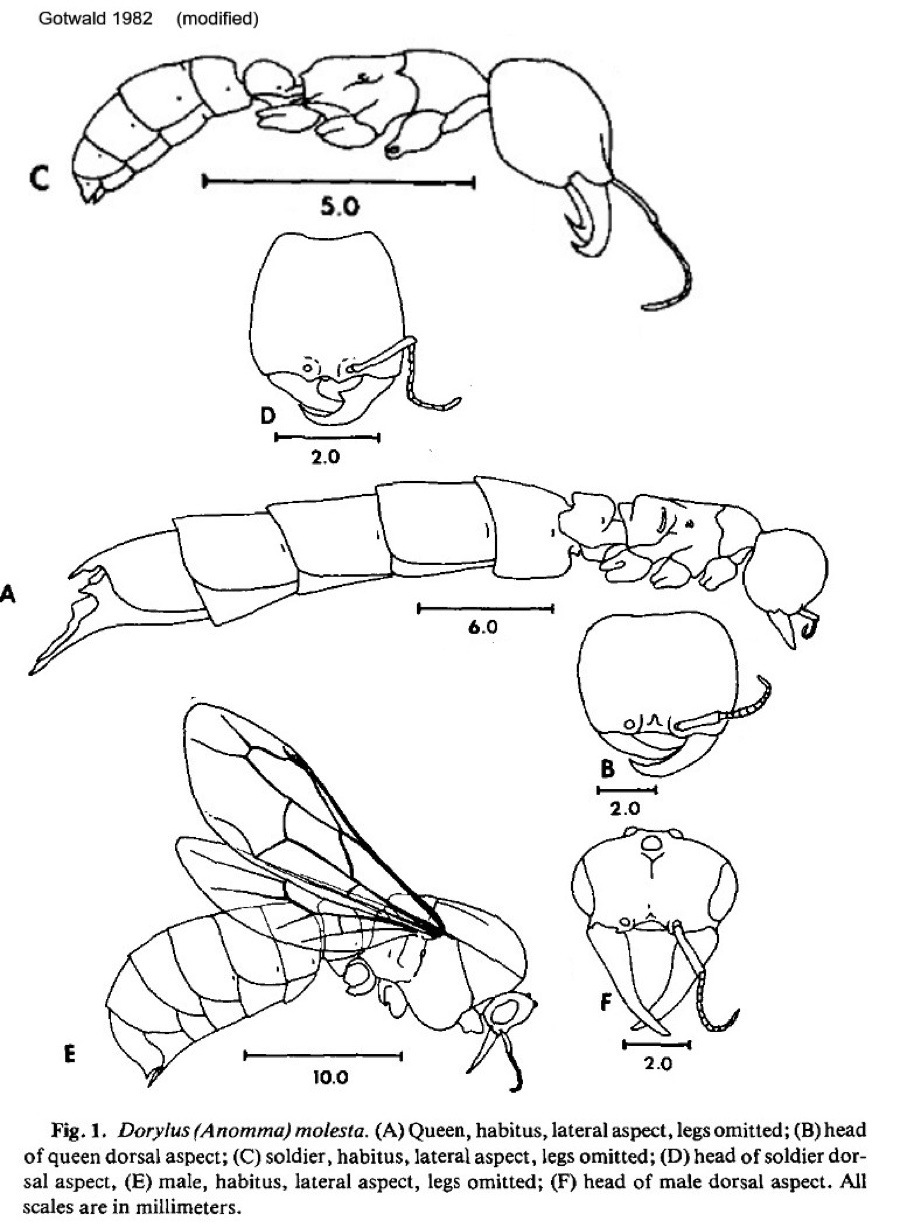 Gerstaecker's
description was cited by Raignier & van Boven (1955) as - "Anomma
molesta, n.sp.; rufo-brunnea, glabra, nitida, capite abdomineque
obscurioribus, mandibulis minus elongatis, apice obtusiusculis, dente
interno posteriore lato, valido, anteriore vix distincto, margine
interstitiali leviter crenulato. Long. lin. 5 [TL = 10.6 mm]". In 1862,
Gerstaecker added that the petiole was distinct, accepted by Wasmann
(1904) and then others, Emery (1899e) etc., as the petiole being
straight and narrow distinct with no postero-ventral teeth (similar to wilverthi
and longer than arcens). Gerstaecker's
description was cited by Raignier & van Boven (1955) as - "Anomma
molesta, n.sp.; rufo-brunnea, glabra, nitida, capite abdomineque
obscurioribus, mandibulis minus elongatis, apice obtusiusculis, dente
interno posteriore lato, valido, anteriore vix distincto, margine
interstitiali leviter crenulato. Long. lin. 5 [TL = 10.6 mm]". In 1862,
Gerstaecker added that the petiole was distinct, accepted by Wasmann
(1904) and then others, Emery (1899e) etc., as the petiole being
straight and narrow distinct with no postero-ventral teeth (similar to wilverthi
and longer than arcens).
From their detailed study of queens, Raignier & van
Boven (1955) decided that the definition by Forel (1912j) was actually
of a specimen identical with that of molestus, as described by
Mayr (1896?) - presumably they referred to the comparative notes in
Mayr's description of Dorylus
emeryi. Forel's descriptions of workers collected in Entebbe,
Uganda, are at  . Note these drawings and
my photographs (soldier and minima) are reasonably matched (the soldier
head is straighter sided and narrower posteriorly than Dorylus
burmeisteri, although the soldier petiole is shown as having
postero-ventral teeth. . Note these drawings and
my photographs (soldier and minima) are reasonably matched (the soldier
head is straighter sided and narrower posteriorly than Dorylus
burmeisteri, although the soldier petiole is shown as having
postero-ventral teeth.
Bernard (1952) wrote that the worker was distinguished
from all races of nigricans by having a slender, matt, petiole,
not enlarged or angular posteriorly; other constant differences are of
the antennae and the face. He did not comment on the posteroventral
teeth. He related how Santschi (1914) thought it was the male of nigricans
var molesta (on the grounds of molesta workers being
the sole highland form of East Africa). However, in Santschi's
collection, he (Bernard) had found the form grouped with stanleyi,
the males being significantly different from nigricans. Thus,
Bernard adopted the view that molesta workers were associated
with the known males of stanleyi. Note - Bernard's use
of stanleyi as the species name would be wrong if the
association with molesta is correct.
Gotwald (1982) gave the illustration (right).
|
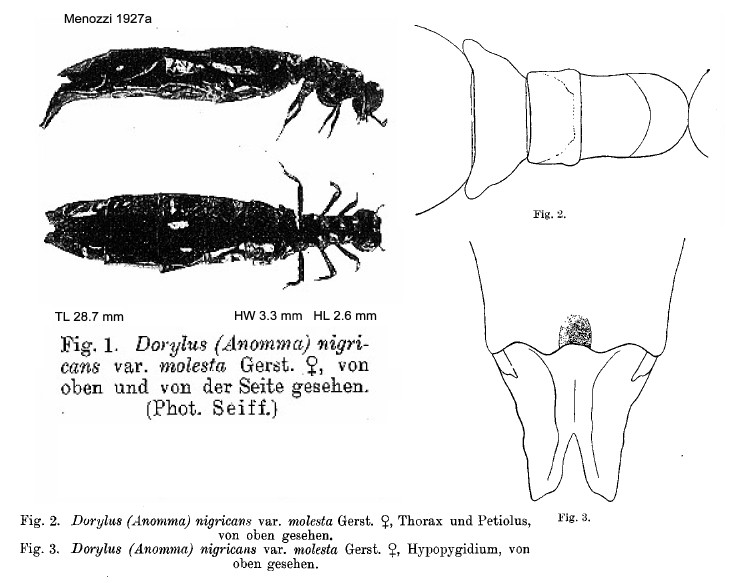 Wheeler
(1922) listed very many findings of molestus (as a
variety of nigricans) from eastern Africa and findings of stanleyi
(males only known) from Congo and several from eastern Africa,
including at 2420 m in Tanzania. Wheeler
(1922) listed very many findings of molestus (as a
variety of nigricans) from eastern Africa and findings of stanleyi
(males only known) from Congo and several from eastern Africa,
including at 2420 m in Tanzania.
Guinea records were workers taken at Yanlé, Gama,
Ziéla (Lamotte) and higher, around 700-900 m, by Villiers in the
north-eastern primary forest of Mt. Nimba. It was less frequent than emeryi
and nigricans, whereas in Katanga stanleyi was dominant
(Bernard, 1952).
In Kenya, Gotwald (1974) investigated molesta
from the central highlands, the Kakamega Forest and in the savannah
(which in Kenya is at above 1500 m). The major prey organism were
insects, although annelids were 22.2% of Forest prey.
|
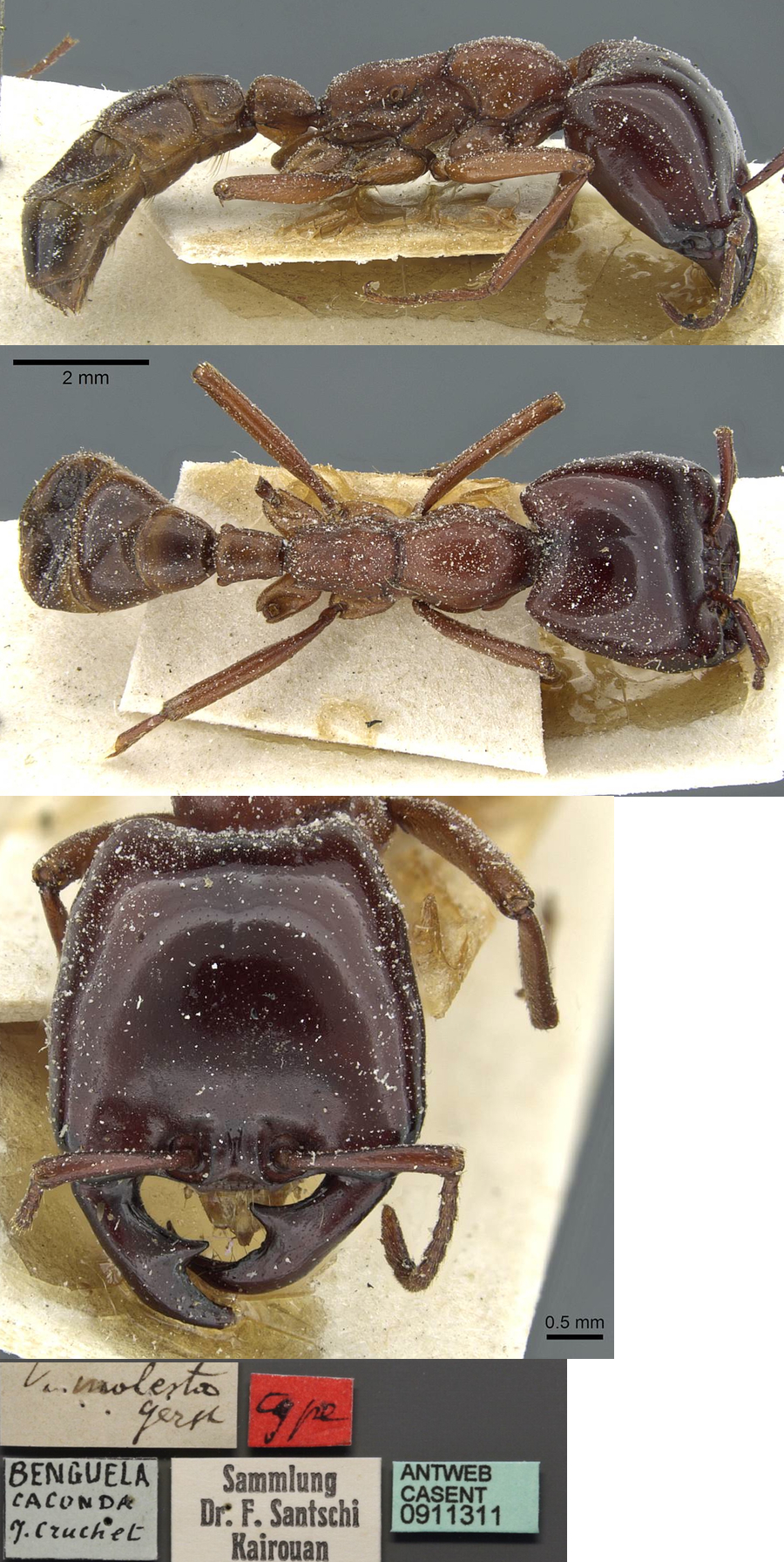 The
photomontage of a major worker from Angola and identified by Santschi
is collated from http://www.antweb.org/specimen.do?name=casent0911311. The
photomontage of a major worker from Angola and identified by Santschi
is collated from http://www.antweb.org/specimen.do?name=casent0911311.
|
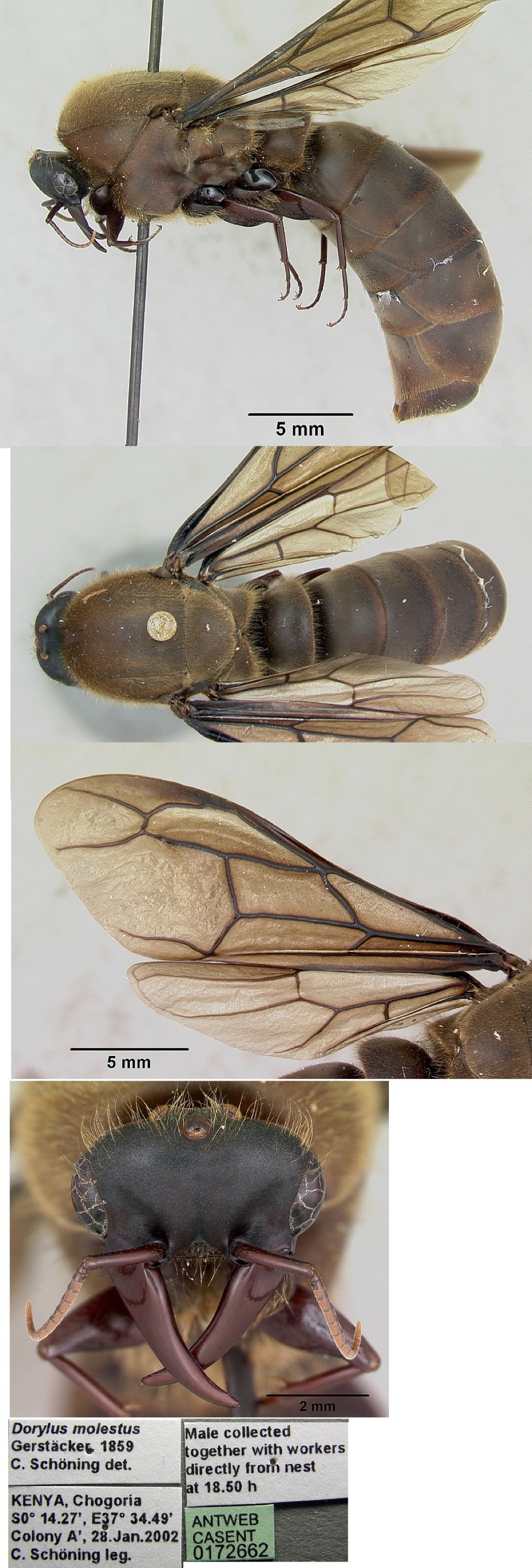 The
photomontage is collated from CASENT0172662 Locality: Kenya:
Chogoria, Colony A'; 00°14'16"N 037°34'29"E; Collection Information:
Collection codes: ANTC7499' Collected by: C.Schöning' Habitat: Date: 28
Jan 2002; Method: male collected together with workers directly from
nest at 18.50 h: http://www.antweb.org/specimen.do?name=casent0172662&shot=p1&project=null The
photomontage is collated from CASENT0172662 Locality: Kenya:
Chogoria, Colony A'; 00°14'16"N 037°34'29"E; Collection Information:
Collection codes: ANTC7499' Collected by: C.Schöning' Habitat: Date: 28
Jan 2002; Method: male collected together with workers directly from
nest at 18.50 h: http://www.antweb.org/specimen.do?name=casent0172662&shot=p1&project=null
See also a major worker at http://www.antweb.org/specimen.do?name=casent0172660&shot=p1&project=null,
collected at Chogoria, Kenya, by Caspar Schđning, 8.i.2002.
Note - this has a postero-ventral process on the petiole and a somewhat
different head shape to that shown by Gotwald (1982) and in the
Degallier specimens I show above.
Photographs of a queen collected in Kenya can be seen at
http://www.antweb.org/specimen.do?name=casent0172663&shot=p1&project=null;
with a male at http://www.antweb.org/specimen.do?name=casent0172663&shot=p1&project=null.
. |
Oxford University Museum
specimens
Dorylus (Anomma) molestus
B Taylor det.
|
Congo
E Zassi
05-t-2-1
|
8-9.xi.2007
Lésio-Louna
03°16'21.7" S
015°28'12.5" E
|
Gallery Forest; 24h
pitfall trap
|
2
|
 |
Dorylus (Anomma) molestus
B Taylor det. |
Central African
Republic
Degallier
|
18.xii.1981
Bozo
18°30' N
5°10' E
|
Migrating column
|
3
|
 |
Dorylus (Anomma) molestus
B Taylor det. |
Kenya
Dupont & Braet
|
24.iii-11.iv.2010
Subukia
0°0'42.9"N
36°14'52.3"E
|
|
2
|
 |
Dorylus (Anomma) molestus
B Taylor det.
|
Tanzania
S Uehara
|
28.ii.2002
Mahale
60°15' S
29° 55' E
|
in forest
|
4
|
 |
Dorylus (Anomma) molestus
B Taylor det.
|
Uganda
S Uehara
III-56
|
8.xi.2002
Kalinzu Forest
0°23'22.7" S
30°5'33.3" E
|
N. of Kanysana,
woodland
|
2
|
|
Dorylus (Anomma) molestus
B Taylor det.
|
Uganda
S Uehara
III-77
|
18.xi.2002
Kalinzu Forest
0°23'22.7" S
30°5'33.3" E
|
near sawmill
|
2
|
 |
Dorylus (Anomma) molestus
B Taylor det.
|
Uganda
S Uehara
III-139 |
24.xi.2002
Kalinzu Forest
0°23'22.7" S
30°5'33.3" E |
S of 409 (W)
|
2
|
 |
Dorylus (Anomma) molestus
B Taylor det.
|
Uganda
S Uehara
III-132
|
21.xi.2002
Kalinzu Forest
0°23'22.7" S
30°5'33.3" E
|
A 122, forest
|
3
|
|
Dorylus (Anomma) molestus
B Taylor det.
|
Uganda
S Uehara
III-133
|
21.xi.2002
Kalinzu Forest
0°23'22.7" S
30°5'33.3" E
|
near Sunzu path,
forest
|
5
|
|
Dorylus (Anomma) molestus
B Taylor det.
|
Guinea
T Humle
Humle 06
|
3.vii.2001
Bossou
7°39'57 N
8°25'08 W
|
hand collected
|
1
|
 |
Dorylus (Anomma) molestus
B Taylor det. |
Guinea
T Humle
Humle 08
|
14.vii.2001
Bossou
7°39'57 N
8°25'08 W
|
hand collected |
4
|
 |
|
 Polymorphism Polymorphism
The photomontage is of workers from the Central
African Republic, collected at Bozo, by Degallier, 18.xii.1981.
The various morphs are shown in detail on the Dorylus (Anomma) molestus
morphs page.
|
 The photomontage is of workers from Tanzania,
collected at Mahale, by S Uehara, 28.ii.2002. The photomontage is of workers from Tanzania,
collected at Mahale, by S Uehara, 28.ii.2002.
The various morphs are shown in detail on the Tanzania & Uganda
morphs page.
|
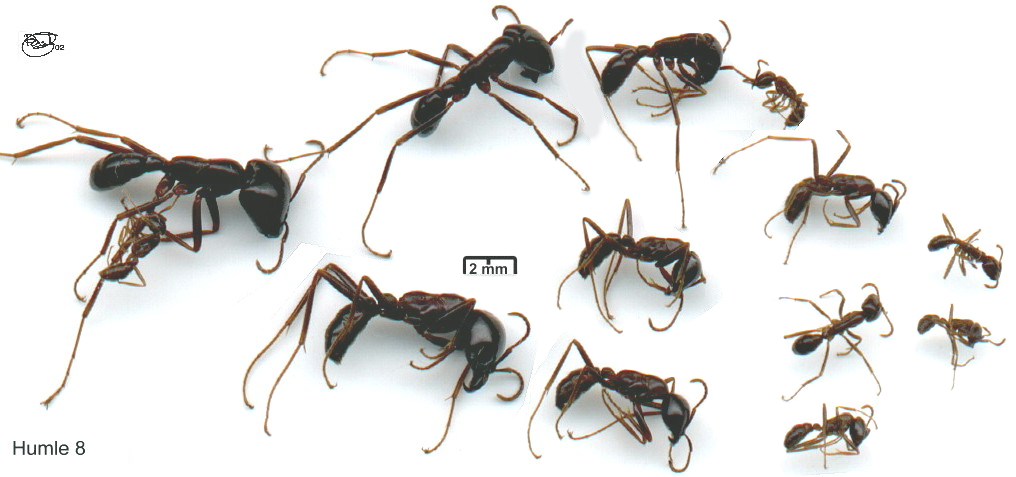 The photomontage is of workers from Guinea,
collected at Bossou, by T Humle, 14.vii.2001 (Humle 8). The photomontage is of workers from Guinea,
collected at Bossou, by T Humle, 14.vii.2001 (Humle 8).
The various morphs are shown in detail on the Guinea morphs page.
|
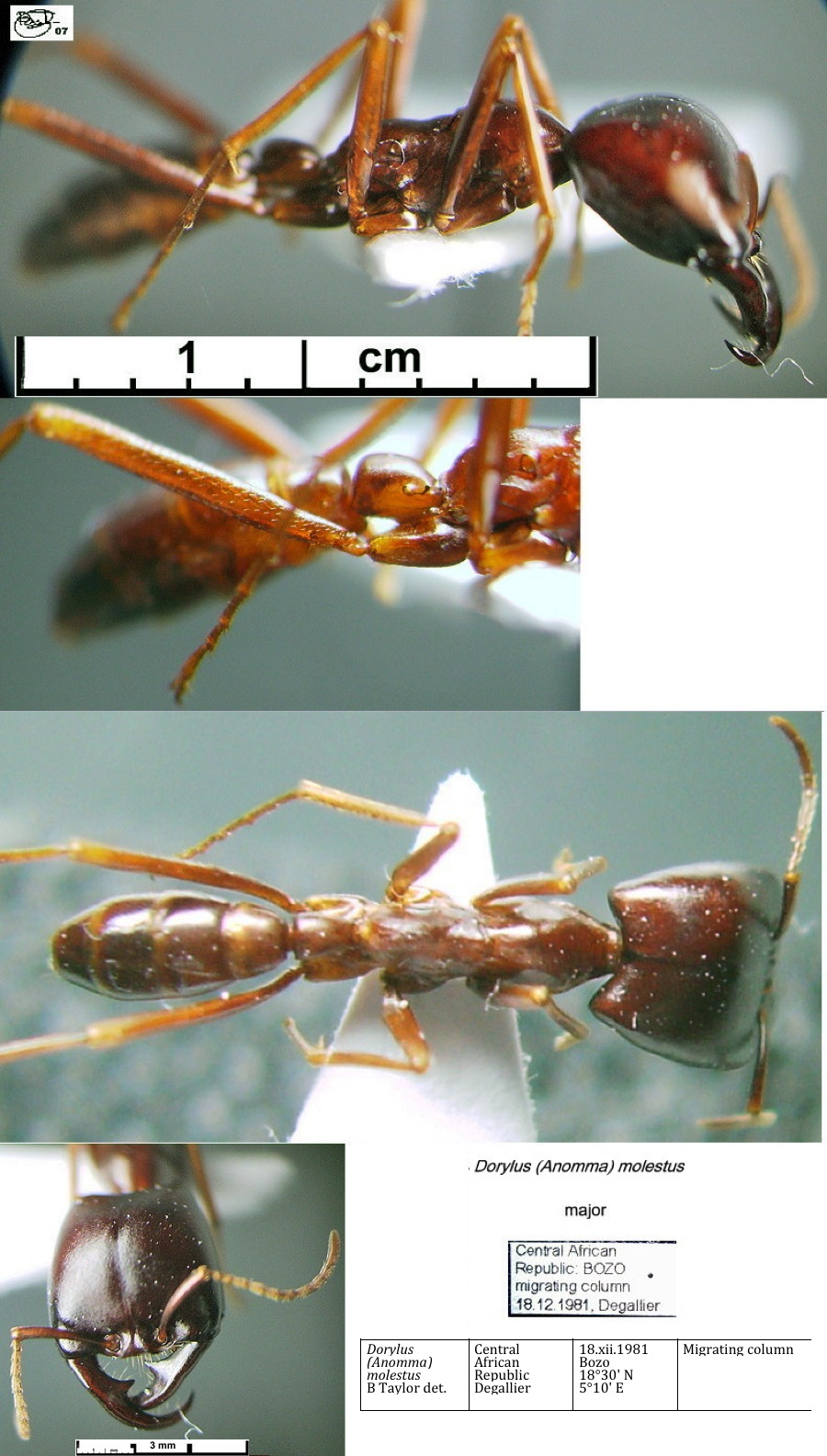 The
photomontage is of a major worker collected in Central African
Republic- Bozo, 08.xii.1981, by Degallier (sent to me by Peter
Hlavac). The
photomontage is of a major worker collected in Central African
Republic- Bozo, 08.xii.1981, by Degallier (sent to me by Peter
Hlavac).
|
Minima
 The
photomontage is of a minima worker from Congo, Réserve de
Lésio-Louna, collected by Eric Zassi (05-t-2-1). The
photomontage is of a minima worker from Congo, Réserve de
Lésio-Louna, collected by Eric Zassi (05-t-2-1).
|
|